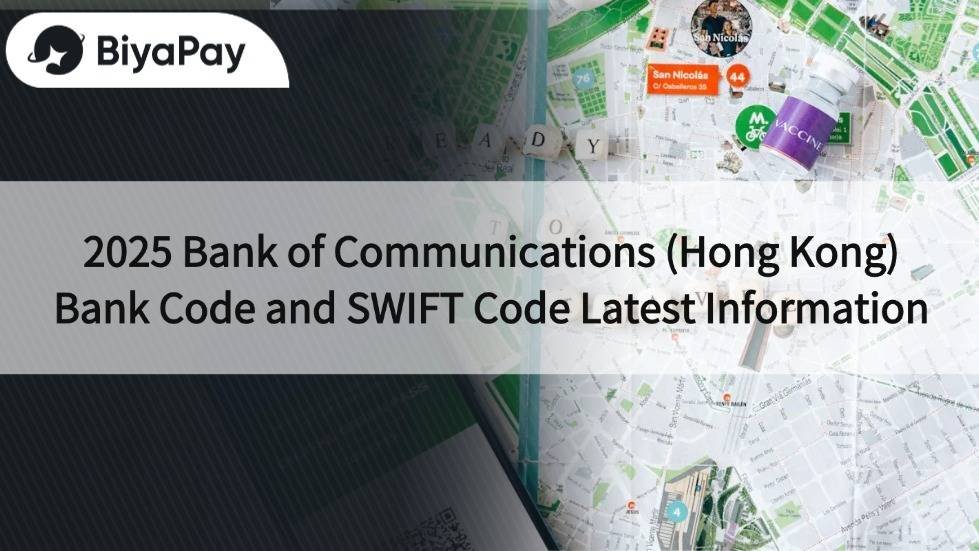- EasyCard
- Trade
- Help
- Announcement
- Academy
- SWIFT Code
- Iban Number
- Referral
- Customer Service
- Blog
- Creator
2025 Bank of Communications (Hong Kong) Bank Code and SWIFT Code Latest Information

Image Source: pexels
When conducting local or international remittances in Hong Kong, you must clearly distinguish between Bank of Communications (Hong Kong) Limited (bank code: 382, SWIFT Code: COMMHKHK) and Bank of Communications Co., Ltd. Hong Kong Branch (bank code: 027). Correctly selecting the relevant bank code and SWIFT Code ensures that funds are securely delivered. If you select the wrong information, the bank may refuse to process your remittance. The following sections, with tables and detailed explanations, will help you quickly find and understand this information.
Key Points
- Bank of Communications (Hong Kong) Limited and Bank of Communications Co., Ltd. Hong Kong Branch have different bank codes and SWIFT Codes, and you must confirm the correct details before remitting to avoid delays or returns.
- The bank code is primarily used for local transfers in Hong Kong, while the SWIFT Code is a standard code for identifying banks in international remittances; their purposes differ, so please use them appropriately.
- When filling out remittance details, carefully verify the bank name, bank code, SWIFT Code, and recipient account number to ensure accuracy and increase the success rate of the remittance.
- You can check the latest bank code and SWIFT Code through the Bank of Communications official website, Wise website, or by calling the bank’s customer service to ensure authoritative and up-to-date remittance information.
- Providing clear remittance purposes and accurate recipient details during remittances helps banks process transactions quickly, avoiding unnecessary delays and reviews.
Bank of Communications Bank Code and SWIFT Code

Image Source: pexels
Bank Code Overview
When conducting transfers or remittances in Hong Kong, you must first confirm the correct bank code of the receiving bank. Each Hong Kong bank has a unique three-digit code. Bank of Communications (Hong Kong) Limited and Bank of Communications Co., Ltd. Hong Kong Branch are separate entities, each with its own bank code. You can refer to the table below to quickly find the relevant information:
| Bank Name | Bank Code | Address (Head Office) |
|---|---|---|
| Bank of Communications (Hong Kong) Limited | 382 | 20 Des Voeux Road Central, Hong Kong |
| Bank of Communications Co., Ltd. Hong Kong Branch | 027 | 20 Des Voeux Road Central, Hong Kong |
- The Hong Kong bank code consists of three digits, with each registered bank having a unique code.
- You can check the complete list of bank codes on the Wise official website, which holds a Hong Kong Money Service Operator license, providing authoritative and reliable information.
- If you want to verify branch codes, you can check the first three digits on your debit card or consult the bank’s official announcements directly.
Tip: When filling out bank details, always select the correct bank code based on the receiving bank. Choosing the wrong bank code may result in funds failing to arrive.
SWIFT Code Overview
The SWIFT Code is an international standard code used to identify banks during cross-border remittances. When making international remittances, you must provide the correct SWIFT Code to ensure funds are accurately delivered to the receiving bank. The SWIFT Codes for Bank of Communications (Hong Kong) Limited and Bank of Communications Co., Ltd. Hong Kong Branch are as follows:
| Bank Name | SWIFT Code |
|---|---|
| Bank of Communications (Hong Kong) Limited | COMMHKHK |
| Bank of Communications Co., Ltd. Hong Kong Branch | COMMHKHH |
When making international remittances, in addition to the SWIFT Code, you need to provide the receiving bank’s name, address, recipient’s name, and account number. According to HSBC (Taiwan) Bank’s official explanation, the SWIFT Code is critical for confirming bank identity in international remittances, while the bank code is primarily used for local transfers in Hong Kong. Their purposes differ, so you must distinguish between them.
You can check the latest SWIFT Code through the Wise official website’s SWIFT code page (https://wise.com/zh-hk/swift-codes/). Official documents remind you that not all bank branches have unique SWIFT Codes; typically, the headquarters’ code can be used. Before remitting, you should confirm the SWIFT/BIC code with the recipient or bank to ensure accuracy.
Note: When making international remittances, you must select the correct SWIFT Code based on the receiving bank. Entering the wrong SWIFT Code may lead to the bank refusing to process your remittance, causing delays or returns.
You can refer to the table below to understand the Nostro Banks and their SWIFT Codes required for international remittances in different currencies:
| Currency | Nostro Bank (Bank Represented by Bank Code) | SWIFT Code (International Remittance Identifier) |
|---|---|---|
| USD | CITIBANK, N.A. / BANK OF AMERICA, N.A. | CITIUS33 / BOFAUS6S |
| GBP | HSBC BANK PLC / BARCLAYS BANK PLC | MIDLGB22 / BARCGB22 |
| EUR | COMMERZBANK AG. / DEUTSCHE BANK AG. | COBADEFF / DEUTDEFF |
| CNY | BANK OF COMMUNICATIONS SHANGHAI MUNICIPAL BRANCH / BANK OF CHINA LIMITED TAIPEI BRANCH | COMMCNSHSHI / BKCHTWTP888 |
| JPY | MUFG BANK, LTD. / MIZUHO BANK LTD. | BOTKJPJT / MHCBJPJT |
This table shows the Nostro Banks and SWIFT Codes corresponding to different currencies for international remittances. You can see that the bank code is mainly used for bank identification, while the SWIFT Code is the international standard code for confirming the receiving bank’s identity during international remittances.
Tip: Before remitting, you should confirm the receiving bank’s bank code and SWIFT Code and verify them with the recipient or bank to ensure accuracy and avoid remittance errors.
Definitions and Uses
Bank Code Definition
The bank code is a three-digit code used in the Hong Kong banking system to identify banks. These codes are primarily used for local transfers and payments to ensure funds reach the designated bank accurately. For example, the bank code for Bank of Communications (Hong Kong) Limited is 382, while that for Bank of Communications Co., Ltd. Hong Kong Branch is 027. When making local remittances, you must provide the correct bank code; otherwise, the funds may fail to arrive.
The role of the bank code is not limited to local transactions. When making international remittances, the bank code, combined with the SWIFT Code, further confirms the bank’s identity and location. This dual verification method enhances transaction accuracy and security.
Tip: You can find the bank code on the bank’s website or in account details. If unsure, it’s recommended to contact the bank directly for confirmation.
SWIFT Code Definition
The SWIFT Code is a standardized code defined by the Society for Worldwide Interbank Financial Telecommunication (SWIFT) used to identify banks in international remittances. These codes typically consist of 8 to 11 letters or numbers, representing the bank code, country code, location code, and branch code. For example, the SWIFT Code for Bank of Communications (Hong Kong) Limited is COMMHKHK, while that for Bank of Communications Co., Ltd. Hong Kong Branch is COMMHKHH.
The primary function of the SWIFT Code is to ensure that international remittances are accurately delivered to the designated bank and branch. It provides a standardized and secure way to send international payments, avoiding errors and speeding up the transaction process. When filling out the SWIFT Code, you should pay special attention to its accuracy, as incorrect codes may lead to delays or returns.
- Uses of the SWIFT Code include:
- Confirming the bank and branch for remittances.
- Ensuring funds flow accurately to the designated account.
- Providing security for international remittances.
Note: Different banks may have varying requirements for SWIFT Code formats. Before remitting, you should confirm the correct SWIFT Code with the receiving bank.
Remittance Purpose
The remittance purpose is an important reference for banks when processing remittances. When making a remittance, you typically need to provide the purpose, such as paying tuition, purchasing goods, or investing. This information not only helps the bank complete the transaction but also meets anti-money laundering requirements.
The correct use of the bank code and SWIFT Code is critical during remittances. Below are key steps in the remittance process:
- Fill in the receiving bank’s name and SWIFT Code to confirm the bank’s identity.
- Provide the remittance purpose, such as “paying rent” or “investing in U.S. stocks.”
- Include the recipient’s name and account number in the remarks field to ensure accurate fund delivery.
- After completing the remittance, retain the bank’s remittance receipt as proof of the transaction.
Different banks may have varying requirements for remittance information. Some banks require you to fill out paper forms in person, while others support online submission. Before remitting, you should carefully read the bank’s guidelines to ensure the information is accurate.
Tip: Accurately describing the remittance purpose not only improves transaction efficiency but also avoids unnecessary delays or reviews.
SWIFT Code Structure

Image Source: unsplash
Structure Explanation
When filling out international remittance details, you will notice that the SWIFT Code typically consists of 8 to 11 letters or numbers. This code is divided into several parts, each with a specific meaning. You can refer to the structure below:
| Part | Position | Description | Example (COMMHKHK) |
|---|---|---|---|
| Bank Code | Positions 1-4 | Represents the bank name | COMM |
| Country Code | Positions 5-6 | Represents the bank’s country | HK |
| Location Code | Positions 7-8 | Represents the city or region | HK |
| Branch Code | Positions 9-11 | Represents a specific branch (optional) | (None) |
If you see an 8-digit SWIFT Code, it usually represents the bank’s headquarters. If it has 11 digits, the last three digits are the branch code. This structure allows you to quickly identify the bank and its location.
Tip: When filling out the SWIFT Code, carefully verify each letter or number to avoid delays due to input errors.
Branch Differences
When remitting in Hong Kong, you will find that most bank branches share the headquarters’ SWIFT Code. For example, all branches of Bank of Communications (Hong Kong) Limited use the code COMMHKHK. Only a few large banks, like HSBC, may have unique SWIFT Codes for certain branches.
You can refer to the following scenarios:
- If the recipient provides an 8-digit SWIFT Code, the funds will first go to the bank’s headquarters and then be allocated to the correct branch by the bank’s internal system.
- If the recipient provides an 11-digit SWIFT Code, the funds will go directly to the specified branch, potentially speeding up processing.
Note: Before remitting, you should confirm with the recipient or bank whether a branch code is required. Some countries or regions have strict requirements for branch codes, and errors may lead to fund returns or delays.
As long as you understand the SWIFT Code’s structure and branch differences, you can process international remittances more efficiently, ensuring secure fund delivery.
Verification and Lookup Methods
Official Lookup
Before making a remittance, you should verify the receiving bank’s details. Official websites and hotlines are the most reliable lookup channels. You can use the following methods to ensure remittance safety:
- Visit the official websites of Bank of Communications or other Hong Kong banks to check the latest bank codes and SWIFT Codes.
- Call the bank’s customer service hotline to directly inquire about branch codes or remittance details from staff.
- Use the Financial Information Service Co., Ltd. website to enter the bank code and check the corresponding bank name.
- Use the consultation services of the Central Bank’s Foreign Exchange Bureau to confirm the legitimacy of financial institutions.
Officials recommend verifying the legitimacy of financial companies or products with regulatory authorities before transactions. This can effectively prevent common scams like underground financial company fraud or counterfeit foreign currency deposit certificate fraud. You should verify whether the counterparty holds a designated foreign exchange bank license and request to accompany or personally verify the authenticity of documents at the issuing bank.
Remittance Precautions
When making a remittance, you must carefully verify all details. Correctly filling out the bank code, SWIFT Code, and branch code significantly reduces the risk of fund delays or losses. Below are common verification steps:
- Check the bank code against the corresponding bank name to ensure consistency with the recipient’s provided information.
- Review transfer or exchange transaction records to confirm the recipient’s account number, amount, date, and currency.
- In case of suspected fraud, first call the National Police Agency’s anti-fraud hotline 165, then contact the bank’s customer service hotline.
- When using online banking, always verify the official website URL to avoid accessing fraudulent websites.
When using services from Bank of Communications or other Hong Kong banks, you should retain transaction records for each remittance. These records, including the recipient’s account number, amount, and transaction date, are useful for future verification. If you have any questions, contact the bank or relevant regulatory authorities immediately.
By correctly using the bank code and SWIFT Code, you can significantly enhance the safety and accuracy of remittances. The system will automatically populate the previously entered Bank of Communications details, reducing input errors. You should ensure the recipient’s name matches the bank records and provide the correct mobile number and email for receiving transaction notifications. Financial institutions periodically update customer information and official contact details to protect your rights. If you have any questions, you can visit the Bank of Communications (Hong Kong) official website: https://www.hk.bankcomm.com/ or call the customer service hotline (+852 223 95559) for inquiries.
FAQ
What is the difference between the Bank of Communications (Hong Kong) bank code and SWIFT Code?
The bank code is used for local transfers in Hong Kong. The SWIFT Code is used for international remittances. You must select the correct code based on the remittance type to ensure secure fund delivery.
Can I use the same SWIFT Code to remit to different branches?
You can. Most Hong Kong bank branches share the headquarters’ SWIFT Code. You only need to provide the correct account number and branch details, and the funds will be allocated automatically.
What happens if I enter the wrong bank code or SWIFT Code during a remittance?
If you enter incorrect details, the bank may refuse to process the remittance. Funds may be delayed or returned. You should double-check all details before remitting.
How can I find the latest SWIFT Code for Bank of Communications (Hong Kong)?
You can visit the Bank of Communications (Hong Kong) official website or call the customer service hotline. The official website regularly updates SWIFT Codes and related information.
Which SWIFT Code is needed for remittances to China?
You need to confirm the SWIFT Code of the specific bank in China with the recipient. Each bank’s code is different. You must provide the correct code to ensure secure fund delivery.
Using the correct bank codes (382 or 027) and SWIFT codes (COMMHKHK or COMMHKHH) ensures secure local and international transfers. BiyaPay offers a single platform for trading U.S. and Hong Kong stocks without needing overseas accounts—start now at BiyaPay! Its cross-border remittances, with fees as low as 0.5%, support USD/HKD conversions (1 USD ≈ 7.8 HKD) across 190+ countries, keeping costs clear.
Track market trends with its economic calendar for smart investments. The 5.48% annualized yield wealth product offers flexible withdrawals. Regulated internationally, it ensures secure transactions. Visit BiyaPay today to streamline remittances and investments!
*This article is provided for general information purposes and does not constitute legal, tax or other professional advice from BiyaPay or its subsidiaries and its affiliates, and it is not intended as a substitute for obtaining advice from a financial advisor or any other professional.
We make no representations, warranties or warranties, express or implied, as to the accuracy, completeness or timeliness of the contents of this publication.




Contact Us
Company and Team
BiyaPay Products
Customer Services
is a broker-dealer registered with the U.S. Securities and Exchange Commission (SEC) (No.: 802-127417), member of the Financial Industry Regulatory Authority (FINRA) (CRD: 325027), member of the Securities Investor Protection Corporation (SIPC), and regulated by FINRA and SEC.
registered with the US Financial Crimes Enforcement Network (FinCEN), as a Money Services Business (MSB), registration number: 31000218637349, and regulated by FinCEN.
registered as Financial Service Provider (FSP number: FSP1007221) in New Zealand, and is a member of the Financial Dispute Resolution Scheme, a New Zealand independent dispute resolution service provider.


















